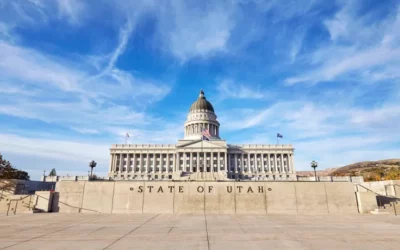
Written by Derek Monson
April 17, 2020
Key Points:
- Regardless of when and how the economy reopens, expert analysis and the data suggest that purchasing food, shopping, traveling, working and entertainment are likely to be different than the past, due to the novel coronavirus pandemic.
- Online shopping for groceries and other items, less crowded restaurants and airplanes, work-from-home arrangements, and digital movie releases may become more prevalent due to demand for greater convenience and avoidance of health risks.
- Demand for innovation in medical care and education may occur for similar reasons.
- Only time will tell what lasting changes to economic life for families and businesses will take hold due to the pandemic.
As Governor Gary Herbert announces his plan to move the state toward reopening portions of the economy in late April or early May, the question lingers: What will economic life look like when that happens?
We have experienced staggeringly high unemployment numbers and record drops in retail sales and industrial production due to social distancing and stay-at-home orders, which have shut down entire sectors of the economy. Some economic experts speculate that consumer demand for goods and services could be “dramatically altered by the COVID-19 crisis.” How we get food, shop, travel, work and entertain ourselves have all changed. Where and how could the pandemic permanently change economic life for families?
Food
The pandemic is changing how people shop for groceries, with 39 million U.S. households using online grocery delivery or pickup services in March – more than double the number who did so in August 2019. Additionally, grocery shopping has changed in other ways, with practices like stocking up and making fewer grocery trips rising in prevalence.
When it comes to the pandemic’s impact on restaurant dining, some food service industry experts predict that up to 20% of restaurants may close nationwide. Others speculate that the pandemic could permanently change restaurants the way 9/11 permanently changed air travel. This could mean helping customers maintain desired levels of social distancing by keeping fewer tables in dining areas.
If customer demand for social distancing when dining out does increase, restaurants will have to find new sources of revenue or cut costs to adjust to making less revenue during peak dining times. This might explain the estimate of restaurant closures, since many establishments will likely prove unable to adjust. It also might mean a quieter, more pleasant dining experience for customers.
Shopping
Even before the pandemic hit, shopping trends were already moving toward online sales. In 2009, online sales were 6.4% of total retail spending. By 2019, it was 16%.
With many brick-and-mortar stores closed at least temporarily due to social distancing and stay-at-home orders, many customers are now being forced to shop online. This could lead to a spike in the number of people who shop primarily or exclusively online, even after the pandemic is under control and stay-at-home orders are lifted. This could lead to a significant decrease in the number of brick-and-mortar stores as well as a significant change in retail jobs – moving away from roles such as cashiers and toward jobs like stocking warehouses for online orders.
Travel
Airlines such as Delta have stopped selling middle seats on airplanes to allow passengers more social distance while traveling. Meanwhile, businesses and event organizers nationwide have turned to video conferencing to hold meetings and conferences that could not be rescheduled.
Certainly, once large gatherings are again allowed, some large conferences will return, with the travel and lodging they require. But what if a significant portion of them choose to continue only as video conferences? Additionally, what if customer demand for adequate social distancing makes middle seats unsellable even after airlines return to trying to sell them? The airline, hotel and conference industries may have to adjust to a world where remote conferences erode their revenue streams. Most likely, some hotels would close, and demand for conference space might decrease.
Work
It is estimated that 37% of jobs can be done remotely. Due to public health measures to rein in the pandemic, many employees have been forced into that very situation. It is also estimated that working from home – due to things like less commuting and less eating out for lunch – saves an employee $4,600 a year.
Once the pandemic is under control, certainly some employers and employees will want to return to working full time in an office setting. It also seems reasonable to believe that others will be drawn to the benefits of remote work – an effective pay raise of $4,600 can be a hard thing to turn down – or will discover from a mandatory remote work period that such an arrangement is a better fit for their business or work style, leading to improved productivity and/or work-life balance.
Even a marginal increase – in the single-digit or low double-digit percentage of the workforce – in remote work arrangements could have significant impacts that ripple through the economy. It could reduce demand for commercial office space in downtown or suburban areas, as well as lead to less congested roads (and less attendant air pollution) during rush hour commutes. It could also have impacts on demand for housing in growing areas: More people could buy homes or rent apartments farther away from their workplace, rather than being limited by commute times to an office.
Entertainment
The pandemic has forced the temporary closure of entertainment venues such as movie theaters and the postponement of concerts and sporting events. What will these things look like when large gatherings are once again allowed?
Some entertainment industries were in decline prior to COVID-19. For example, movie theater admissions declined 5% in 2019, with 2017 and 2019 being the worst years for cinema since the mid-1990s. In another example, attendance at college football dropped 7.6% from 2014-2019, with more people choosing to watch games on TV than in the stadium.
When these sources of entertainment are again open for business, will a public newly sensitized to the need for adequate social distancing pack into a crowded entertainment venue? Will digital releases of new movies, live-streamed concerts and sporting events without fans become the norm?
Some anecdotal evidence suggests this may not be the case. But it is possible that the entertainment industry may have to adapt its business model to a customer base that prioritizes health risks as much as entertainment value.
Food, shopping, travel, work and entertainment are only a few of the economic sectors that could be permanently changed by the current pandemic. How we provide medical care and how we educate children could also be permanently changing before our eyes.
One gets the sense that life will never be the same, but no one knows yet just how economic life will change for businesses and families. As the pandemic is brought under control and people have the opportunity to once again normalize their lives, employers, employees, customers and producers will decide through their own choices how the economy will change or return to how it was before. Because that is how the free market works.
More Insights
Read More
Are ‘empowerment accounts’ the answer to poverty and self-sufficiency? With Vance Ginn
What if there were a more effective way to improve the prospects of families trying to escape poverty that would save taxpayer dollars?
Utah should prepare for changes to the U.S. Department of Education. Here’s how
States may have a unique opportunity to evaluate what state and local control really means without the same pressure from D.C. that has existed in the past.
Sutherland launches effort to recognize school districts for transparency and parental access
The Partners in Learning Certificate recognizes school districts that foster openness, trust, and collaboration between schools and families.


